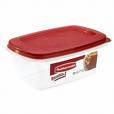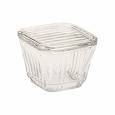 Tupperware:
Tupperware: Maybe the epitome of the 1950s, but the quest for a well-organized kitchen persists. To see tidy stacks of food-filled plastic containers in the fridge and freezer is comforting in a primal kind of way. But then comes the procession of warnings about storing and cooking food in plastic, and leaching chemicals, and hormone disruption, and ACK!

So here it is: The lowdown on plastic food containers. Learn which plastics to
never use with food, read 12 tips about plastic in the kitchen, and see some swell inert alternatives.
 First:
First: Flip over your favorite plastic food storage container and check the recycling code number. If you spy a number 3 or 7, well, those containers should probably go to the craft room or garage to store buttons or screws rather than food. If there is no number listed, contact the manufacturer. (And to be fair to Tupperware, they do manufacture products that are not made of these plastic types.)
x
For in-depth but easy-to-read information on plastics, just
email Alice (subject line: PLASTIC Info), and she’ll send you more than you ever wanted to know about plastic and food. Meanwhile, here’s our tips:
1. Know your plastics. Plastic items are marked with a resin identification coding system (the number surrounded by arrows), which stand for:
1. polyethyelene terephthalate (PETE)
2. high-density polyethylene (HDPE)
3. vinyl, polyvinyl chloride (PVC)
4. low-density polyethylene (LDPE)
5. polypropylene (PP)
6. polystyrene (PS)
7. other (includes polycarbonate, acrylic, polylactic acid, fiberglass)
2. When you need to use plastic, these are the safer choices to use with food:
1, 2, 4 and 5.
3. Learn to recognize, and then avoid, polycarbonate (number 7) for food usage. Polycarbonate plastics are hard and clear. Common items made from this BPA-containing plastic are food storage containers, baby bottles, water bottles, bowls and tableware. (And the lining inside food and drink cans, by the way.)
4. If you don't get rid of all of your plastic, at least retire old plastic containers, especially those that are heavily worn or scratched. Older plastics tend to leach increasing amounts of toxins as they age. Use them to organize and store non-food items.
5. Be careful of serving and storing hot foods or foods made with fats or oils in plastic containers. These foods more readily facilitate the transfer of plastic toxins.
 6.
6. Never microwave foods in plastic containers. "Microwave safe" means the container won't melt or warp, but doesn't mean it won't leach. Heating plastics increases the potential for leaching of chemicals into your food.
 7.
7. Never microwave food in yogurt tubs, take-out bowls, or other one-time use containers. These containers can warp or melt, possibly causing harmful chemicals to migrate into the food.
 8.
8. Avoid using plastic sandwich bags or plastic wrap products.
9. If you must use plastic wrap, make sure it is a brand free of both BPA and PVC. Ziploc, Glad and Saran are promoted as being free of BPA and PVC—but remember that these plastics live for 1,000 years…in our landfills.
 10.
10. Avoid deli-wrap and similar generic packaging since you can't ascertain the plastic type used. When sliced cheese and meats are sold in plastic bags and/or plastic deli wrap, transfer them as soon as possible to unbleached wax paper or a safe container.
11. Remember that if you are pregnant or nursing, BPA chemicals are passed through your bloodstream directly to your baby.

Instead of mixing petroleum (i.e. plastic) with your food, use inert alternatives such as glass and ceramic rather than plastic food storage containers. Reusing jars is a win-win—and you can often find glass storage containers at flea markets and thrift shops. Or simply store food in bowls covered with a plate.
Try alternatives like these:
Pyrex Food Storage containers

The versatility of PYREX glassware extends to storage dishes in an array of convenient, stackable sizes with plastic lids for safe-keeping. Better yet, those same storage dishes are perfect for reheating and serving, since they're resistant to both heat and cold. Compared to the plastic counterparts, PYREX glassware storage dishes do not stain or retain food colors, tastes or odors, AND they’re no-toxic when reheating food in the microwave!
Crate and Barrel's Refrigerator Dish for $5.95
Rugged, refrigerator dish in ribbed glass with a heavy glass lid goes from oven to table to freezer in style, too.
 Heat-tempered
Heat-tempered
Will not retain odors or flavors
Dishwasher- and microwave-safe
Wrap-N-Mat machine-washable sandwich wrappers (a great replacement for plastic baggies that pay for themselves over a short time)
Wrap-N-Mat Set of 3 for $18.95
 Replaces wasteful plastic sandwich and snack bags
Replaces wasteful plastic sandwich and snack bags
Pays for itself over time
Only reusable sandwich wrap and place mat in one
Lightweight
Made with Fair Labor/Fair Wages
Machine washable, air dry
Food safe, PEVA liner that wipes clean
Available in Blue, Green, Red Check and Eco-Print
Approximately 13 x 13 when open
Contribute to the Cook'n Club!
DVO would love to publish your article, prose, photography and art as well as your cooking, kitchen and nutrition tips, tricks and secrets. Visit the Newsletter Submission / Win Win for All section in our Forum for more information and details.



